For practice, I attempted to make a VHDL code to run Rotary encoder hardware. It was full with debounce, quadrature decoder and an up/down counter codes.
Unfortunately, when running simulation with a testbench, my results were disappointing so I decided that each block needs to be analysed separately. For the debounce code, I created a symbol file and produced the circuit below
While attempting to debounce the testbench signal in simulation, I found out that my results were terrible so I believe I am missing something.
The VHDL code for the encoder block can be found here :
LIBRARY ieee;
USE ieee.std_logic_1164.all;
USE ieee.std_logic_unsigned.all;
ENTITY debounce_a IS
GENERIC( counter_size : INTEGER := 8); --counter size (8 bits gives 51.6 us with 5MHz clock)
PORT(
clk : IN STD_LOGIC; --input clock
bounce_a : IN STD_LOGIC; --input signal to be debounced
result : OUT STD_LOGIC); --debounced signal
END debounce_a;
ARCHITECTURE logic OF debounce_a IS
SIGNAL flipflops : STD_LOGIC_VECTOR(1 DOWNTO 0); --input flip flops
SIGNAL counter_set : STD_LOGIC; --sync reset to zero
SIGNAL counter_out : STD_LOGIC_VECTOR(counter_size DOWNTO 0) := (OTHERS => '0'); --counter output
BEGIN
counter_set <= flipflops(0) xor flipflops(1); --determine when to start/reset counter
PROCESS(clk) -- occurs within a clock event
BEGIN
IF(clk'EVENT and clk = '1') THEN -- can be rising_edge(clk)
flipflops(0) <= bounce_a; -- adresses the signal as a set value
flipflops(1) <= flipflops(0);
If(counter_set = '1') THEN --reset counter because input is changing
counter_out <= (OTHERS => '0'); --set all bits to '0'
ELSIF(counter_out(counter_size) = '0') THEN --stable input time is not yet met
counter_out <= counter_out + 1;
ELSE --stable input time is met
result <= flipflops(1);
END IF;
END IF;
END PROCESS;
END logic;
It could be filled to the brim with unwanted logic because I had a limited idea of what I was doing and I took a friends general debounce code and edited it to try and fit my specific needs.
If anything extra is needed I am willing to provide. I feel like it's a pretty basic error but I just need any sort of help.
Here is a look on the testbench code that I used if that helps identify toggling properties :
LIBRARY ieee;
USE ieee.std_logic_1164.all;
ENTITY decodeblock_vhd_tst IS
END decodeblock_vhd_tst;
ARCHITECTURE decodeblock_arch OF decodeblock_vhd_tst IS
-- constants
CONSTANT clk_period : TIME := 20 ns;
CONSTANT num_clk_cycles : INTEGER := 100;
-- signals
SIGNAL b_Input : STD_LOGIC;
SIGNAL b_output : STD_LOGIC;
SIGNAL CLOCK_50 : STD_LOGIC := '0';
COMPONENT decodeblock
PORT (
b_Input : IN STD_LOGIC;
b_output : OUT STD_LOGIC;
CLOCK_50 : IN STD_LOGIC
);
END COMPONENT;
BEGIN
i1 : decodeblock
PORT MAP (
-- list connections between master ports and signals
b_Input => b_Input,
b_output => b_output,
CLOCK_50 => CLOCK_50
);
init : PROCESS
-- variable declarations
BEGIN
b_input <= '0',
'1' after 1.1 ns,
'0' after 2.9 ns,
'1' after 5.1 ns,
'0' after 7.6 ns,
'1' after 9.9 ns,
'0' after 12.5 ns,
'1' after 15.4 ns,
'0' after 18.6 ns,
'1' after 22.1 ns,
'0' after 25.9 ns,
'1' after 29.7 ns,
'0' after 33.8 ns,
'1' after 38.2 ns;
-- variable declarations
for i in 1 to num_clk_cycles loop
CLOCK_50 <= not CLOCK_50;
wait for clk_period/2;
CLOCK_50 <= not CLOCK_50;
wait for clk_period/2;
end loop;
WAIT;
END PROCESS init;
always : PROCESS
-- optional sensitivity list
-- ( )
-- variable declarations
BEGIN
-- code executes for every event on sensitivity list
WAIT;
END PROCESS always;
END decodeblock_arch;

